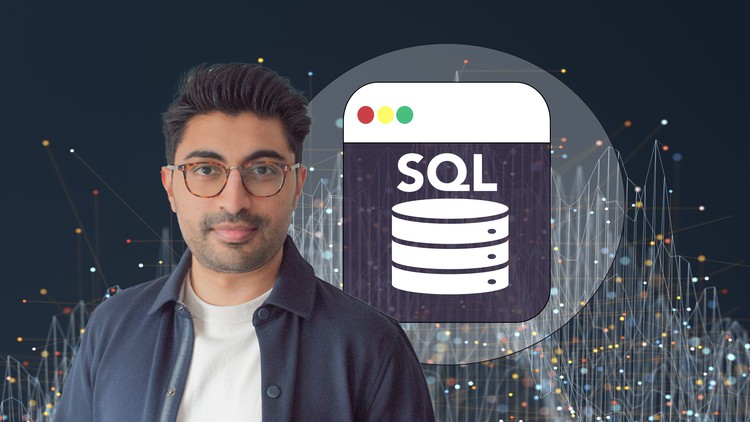The Comprehensive SQL Course
- Description
- Curriculum
- FAQ
- Reviews
Want to learn one of the most in-demand skills in the business and technology sector?
Then this course is for you!
SQL skills are highly marketable everywhere, especially in companies like Netflix, Facebook, Amazon, Google… the list goes on and on… The simple fact is that if you want to do any work involving data, then the chances are that you need to know SQL!
This course has been designed for:
-
Individuals with no prior experience in SQL and looking to make that step to develop their skills in this highly sought after programming language
-
Those with some experience looking to brush up on their SQL knowledge
No downloads or software installation required! We will be using Oracle APEX which is a web-based application – you will be set up with your own virtual database hosted on the cloud! Although we will be using Oracle APEX the course has been designed to highlight key differences between some of the main Database Management Systems such as MySQL and Microsoft SQL Server, so what you learn in this course can be applied across all platforms supporting SQL.
The lectures in this course are arranged into short, bite-sized chunks. The course is designed to be comprehensive, but also concise in order to make the learning experience as easy as possible. Every technical section of the course will be rounded off with quizzes / assignments and give you an opportunity to develop your practical skills.
The course will provide students with an extensive Question Bank section which is full of questions and walkthroughs designed to emulate real world scenarios and combine together all of the different SQL clauses, operations and commands taught in this course!
In this course you will learn about:
-
Data Definition Language Commands such as CREATE, DROP, TRUNCATE, ALTER and RENAME
-
Data Query Language Commands using the SELECT statement
-
Data Manipulation Commands such as INSERT, UPDATE and DELETE
-
Data Control Language Commands such as GRANT and REVOKE
-
Transaction Control Language commands such as COMMIT and ROLLBACK
-
Data Types
-
Qualifying Column Names
-
Aliasing Columns and Tables
-
Row Level Functions
-
Aggregation Functions
-
The Where Clause
-
The Group By and Having Clauses
-
The Order By Clause
-
Single Table and Multiple Table Joins
-
SET Operators
-
Subqueries
-
Database Constraints
-
Relational Databases and Data Model Design including STAR and SNOWFLAKE Schemas
-
Views
-
1Course OverviewVideo lesson
-
2Getting Set Up On Oracle APEXVideo lesson
-
3Oracle APEX OverviewVideo lesson
-
4Exploring The Countries Sample DatasetVideo lesson
-
5Important infomation relating to Oracle APEX Sample DatasetsVideo lesson
-
6What Is SQL?Video lesson
-
7TablesVideo lesson
-
8Basic Database TerminologyVideo lesson
-
9Your First SQL QueryVideo lesson
-
10QuizQuiz
-
11Section OverviewText lesson
-
12String Data TypesVideo lesson
-
13Numerical Data TypesVideo lesson
-
14Date Data TypesVideo lesson
-
15The Describe StatementVideo lesson
-
16Simple Mathematical OperatorsVideo lesson
-
17Guidance And Documentation On Data TypesVideo lesson
-
18Useful External Links On Data TypesText lesson
-
19QuizQuiz
-
20Section OverviewText lesson
-
21The 5 Types of SQL CommandsVideo lesson
-
22Data Query LanguageVideo lesson
-
23Select DistinctVideo lesson
-
24Data Definition LanguageVideo lesson
-
25Note On String and Numerical ValuesText lesson
-
26Data Manipulation LanguageVideo lesson
-
27Data Control LanguageVideo lesson
-
28Transaction Control LanguageText lesson
-
29Assignment QuestionsText lesson
-
30Assignment Solutions WalkthroughVideo lesson
-
31Assignment Solutions (SQL Code)Text lesson
-
37Section OverviewText lesson
-
38Operators And The Where ClauseVideo lesson
-
39Some Examples Using The Where ClauseVideo lesson
-
40An Important Note About Case Sensitivity In SQLText lesson
-
41Introduction To The Case StatementVideo lesson
-
42Examples With The Case StatementVideo lesson
-
43Revisiting The DML Update CommandVideo lesson
-
44Assignment QuestionsText lesson
-
45Assignment Solutions WalkthroughVideo lesson
-
46Assignment Solutions (SQL Code)Text lesson
-
47Section OverviewText lesson
-
48Installing The Employees (EMP/DEPT) Sample DatasetVideo lesson
-
49The CAST FunctionVideo lesson
-
50Date Values and FormattingVideo lesson
-
51Date FunctionsVideo lesson
-
52String FunctionsVideo lesson
-
53Mathematical FunctionsVideo lesson
-
54Useful External Links On FunctionsText lesson
-
55Assignment QuestionsText lesson
-
56Assignment Solutions WalkthroughVideo lesson
-
57Assignment Solutions (SQL Code)Text lesson
-
58Section OverviewText lesson
-
59Aggregate FunctionsVideo lesson
-
60Count(*)Video lesson
-
61Aggregate Functions And The Where ClauseVideo lesson
-
62Aggregate Functions And Group ByVideo lesson
-
63Single Column Group ByVideo lesson
-
64Multi Column Group ByVideo lesson
-
65Non-Aggregated ColumnsVideo lesson
-
66Group By And The Having ClauseVideo lesson
-
67Group By On Numerical FieldsVideo lesson
-
68Order ByVideo lesson
-
69Order Of ExecutionVideo lesson
-
70Assignment QuestionsText lesson
-
71Assignment Solutions WalkthroughVideo lesson
-
72Assignment Solutions (SQL Code)Text lesson
-
73Section OverviewText lesson
-
74Introduction to the Join OperationVideo lesson
-
75Simple JoinVideo lesson
-
76Joining Multiple TablesVideo lesson
-
77Joining On Multiple ColumnsVideo lesson
-
78Assignment QuestionsText lesson
-
79Assignment Solutions WalkthroughVideo lesson
-
80Assignment Solutions (SQL Code)Text lesson
-
81Section OverviewText lesson
-
82SQL Query Order Of ExecutionVideo lesson
-
83Fetch, Limit And TopVideo lesson
-
84SubqueriesVideo lesson
-
85Subqueries And JoinsVideo lesson
-
86Assignment QuestionsText lesson
-
87Assignment Solutions WalkthroughVideo lesson
-
88Assignment Solutions (SQL Code)Text lesson

External Links May Contain Affiliate Links read more





